Glimpses from a Hare Krishna community in Hungary.
By Radha Krishna Dasa, Andras Kun and Szilvia Riv of Eco valley Foundation
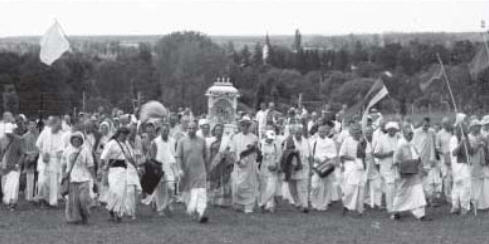
October 15, 2009; 3 pm; Krishna valley, Central Europe, Hungary, in the outskirts of the Parish of Somogyvamos. We take part in a mid afternoon sight seeing tour of the second Sustainability Conference. Our guide is a monk living in Krishna valley, who relishes our round of the village with thrilling stories. It turns out that this is the second conference and even though last year there were merely 140 participants, this year more than 420 people came together for one of the largest sustainability conferences in Europe. However, the question may arise: why do the Hungarian Hare Krishna devotees organize a scientific conference on sustainability? Why are people so interested in it? Why do they come from all over Hungary and from all over the world? These and all our other curious questions are answered during the afternoon.
The walk in time and space reveals the recent history of Krishna valley, which is a quite special, unique example of community building, collaboration of individuals and a lifestyle aiming at harmonious coexistence with natural environment. Krishna valley is far famed for its favorable results regarding sustainability and the inhabitants’ exemplary ecologic lifestyle. Dozens of scientists, teachers, university and college students come here to learn and ferret about the artfulness of organic farming. Tens of thousands visit every year to see this model of organic farming and the dairy farm. Nevertheless, there is a common destination during every walk: the temple. All visitors who come with manifold purposes and also the participants of this conference have had the auspicious opportunity to see the dearest secret of Krishna valley, the source of all prosperity: the altar with the presiding Deities of Hungary, the gleaming forms of Tribhuvana Sundara Sri Sri Radha ShyamaSundara.
A travel in time: History of Krishna valley in a nutshell

The history of Krishna valley goes back to the beginning of the 1990’s. After the collapse of the communist regime the opportunity to fulfil a long cherished wish became true: to follow and implement the instructions of His Divine Grace A.C. Bhaktivedanta Swami Prabhupada and lay the foundations of a Krishna conscious farming community in Hungary. Following the desire of the Hungarian leader of ISKCON, Srila Sivarama Swami, and with the leadership of Gaura Sakti Dasa, the community succeeded in buying a sizeable plot of rural land in 1993. And from then on such a thing commenced which and this is possibly not an overstatement is peerless in the history of ISKCON.
First the temple came in 1996. The temple walls were made out of brick and locally mined clay. Besides lime, clay, and cement, the most powerful bonding material, the devotion of the builders, makes the walls stable. All indoor works, decorations, sculptures, and paintings of the temple walls are works of devotee artists. The largest Krishna temple in Central Europe was completed in this way.
The Deities were installed in 1996 and Their presence in Krishna valley has been more and more perceptible ever since then. Srila Sivarama Swami’s pure devotion and tremendous effort make it possible for the inhabitants to serve Radhe Shyama. The Deities, on the other hand, shower Their mercy onto the devotees. This is the most confidential secret of Krishna valley and consequently the force through which Krishna valley’s story has become a successful one from both a material and spiritual point of view.
Guests describe the place in the following way: “tranquil,” “peaceful and silent,” “attractive scenery,” “calm and kind people.” They come back if they have a chance.
Agriculture has been planned and developed since 1995 and landscape has been formed by complex management. The important standpoints of agricultural planning and implementing are ahimsa, self sufficiency, ecologic aspect and long term sustainability. As a result, organic farming and moderate resource use is in progress from the very first day. On the 230 hectare land bought by the Hare Krishna people, which used to be a large scale plough land and an intensive sheep walk, we see something completely different…
A walk in present: Sights of Krsna valley
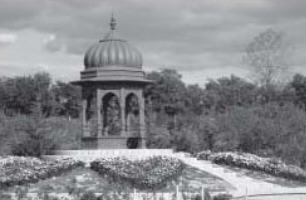
Krishna valley is not solely an eco village developing in a plain valley as the ground is much diverse. The main valley is ramifying into smaller side valleys and if we look around, we see gentle slopes and steep slants with wide hills in all directions. In the middle of the territory, in the deepest section of the valley, there is a streamlet. Its special feature is that the source is an affluent fountain found in the area of Krishna valley. The streamlet has been dammed up in several places creating various ponds and later on groves were planted around them with refreshing microclimate.
After we have passed the pillars marking the gate of Krishna valley guarded by life size sculptures of elephants, we arrive at a little pond situated along the bank of the stream. Next to it there is a red pavilion sparkling like a crest jewel in the sunny autumn. Wide stairs lead one from the pavilion to the pond and also under the water. As we are approaching, little fish and other tiny aquatics basking in the sunshine underwater scatter all over the pool. We are in Mathura, one of the places where Lord Krishna performed His pastimes.
Last year in Krishna valley there were fourteen places marked with pavilions each depicting holy places, or as guests call them, lay bys. Actually, these are the principal scenes where the Lord performed His pastimes. Sivarama Swami Maharaja revealed the exact spot of these holy places during the last few years. Several dozen places were revealed later. The most significant ones have been developed to serve as a place of meditation and devotion. Tourists also love these small parks as they can relax in the shades of pavilions and trees, and in the meantime, even without being aware of it, they become associated with a spiritual experience.
If we go further along the stream, the valley unfolds in front of our eyes. Hills that were close to us gradually move away from each other, as the valley becomes wider and the stream quirky. On both sides of the road we see the flora of the Botanical Garden. These days there are around 900 different young tree and shrub species in the 12 hectare large botanical garden. As a matter of curiosity concerning valley and surrounding hills, the natural vegetation of the region has revived in smaller areas. Previously barren lands are rich in grass, the youthful weeping willows and shrubs on the banks of the stream have grown up and give shelter to the birds nesting in the area. So far 111 species have been observed.
In the last sixteen years not only ornamental trees were planted in Krishna valley, but around 250,000 other sorts of saplings as well. It is going to be a part of steadily growing forest belts, plantations and woods that will ensure appropriate windbreak and microclimate besides providing firewood for the community.
Above the botanic garden on the side and top of the hills are the arable lands that provide wheat and other grains for the community as well as the pasture for cows and oxen. We diverge from the line of the stream and go uphill on a steep slope in between pastures. On the spot of the most beautiful scenery encircled by harsh green lawn we arrive to a glittering yellow building. This is the gurukula or the school of Krishna valley. The exterior is decorated with elements of Indian architecture, but the interior has met the demands and functions of a school. Children of Krishna valley learn here from the age of six to fourteen. The school became state accredited in 2009. Besides learning according to the national curriculum, the new generation is acquainted with the philosophy, music and drama of the Krishna conscious culture as well as with indispensable bases of a farming community like organic farming and ecological elements.
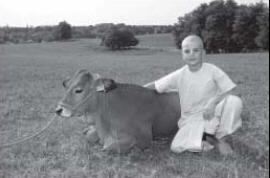
Slowly we get to a hilltop strolling next to grazing cattle and pastures that greened out owing to autumn rainfalls. Here we find another imposing building: the gosala, or the Centre for Cow Protection. This is the home to 18 cows, 19 oxen and one bull, Nandi. Nandi is from an Indian zebu breed and grew into a pedigree bull in Krishna valley. A special feature of zebu is that it can outstandingly endure heat and drought despite climate changes happening due to global warming.
All machine tools in Krishna valley like ploughs, cultivators, threshers and reapers, winnowers, fanners, etc. operate on ox power. This is an important principle of self sufficiency: minimizing the use of fuel, oil or petrol. Agricultural produce in Krishna valley provides full self sufficiency for several years in cereals, fodder crops as well as soilage.
Besides providing ox power, the gosala also supplies the community with milk and cow dung for agriculture. Manure is mainly used by the gardening department and for cultivating plants in arable land. Devotees in Krishna valley developed a specific composting technology, where cow dung is mixed with organic waste and scobs.
In the organic garden, which is near the temple complex, they grow nearly 70 kinds of vegetables and herbs. In summer when there is a lot to do in the gardens, all inhabitants of the village take part in communal work, which happens two times a week and lasts for an hour. At that time, gardeners serve alongside members of the community, tourist guides, teachers, accountants, cowherds, and cooks. Self sufficiency for the whole year became a reality when two years ago the works on the three aisle cellar were finished. In this way gardeners are able to manage seasonality, which is so characteristic of temperate zones. In this manner all vegetables and different kinds of fruits can be well stored from autumn until the time when first produces become ripe next year. In addition to all this, preservation of jams, bottled fruits and various juices complete the products of organic gardening.
Model for sustainable society
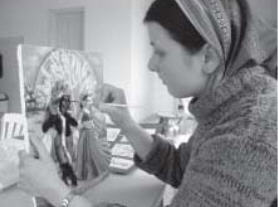
Mere living together is not the only factor that keeps the community together. Krishna valley is primarily a spiritual community, centered on service to Sri Sri Radha Shyamasundara. In the middle of Krishna valley, at the most prominent location is the temple. It also houses the lacto vegetarian restaurant that is very popular with guests. From the terrace of the restaurant, one can see the houses of the spiritual community, where the paths are decorated with alleys and small gardens. Inhabitants do not lack guests: there are around 25,000 to 30,000 guests each year, who have a guided tour of the temple and have a glimpse into the daily activities of the eco village and secrets of organic farming.
Among the many eco villages founded in Hungary, Krishna valley is rated as the most successful. In the past 16 years, the population grew from the initial 40 people to nearly 140 by today. The favorable achievements of Krishna valley are most thoroughly described by sociologists: the community, their unifying faith of the community, their experience and transcendental knowledge are the elements that provide the inevitable energy for its functioning.
A few years ago the leaders of Krishna valley decided that the village is ready to be demonstrated to the public as a model for sustainability. Ecological and economic crises in the world during the last decade made people sensitive regarding this matter. Insight into it shows that the 16 year old spiritual community evolved on the basis of Bhagavad gita represents an exemplary model for sustainability even from the point of view of exacting scientific criteria.
Communicating this fact and demonstrating the model to the public can hardly wait as scientists claim that all the crises phenomena are going to get stronger if humanity in general does not change its present lifestyle. The secret of Krishna valley is not a secret in reality: all of it can be read in Vedic scriptures. If people follow principles described in those pages, then they can properly use all facilities of the material world. This is the same deduction which is suggested by the researches of modern science: if we destroy, pollute and waste our resources, then gradually they are going to vanish as a reaction to this.
Since 2008, the Eco valley Foundation is the organizer of researches and educational programmes. They organize conferences and as it has already been mentioned they organized the second conference in 2009. Several dozens of university students and researchers coming to perform their studies, cooperative documentations signed regarding educational and research projects, numerous lectures in connection with this specific scientific field, as well as many articles and studies published likewise indicate great social interest.
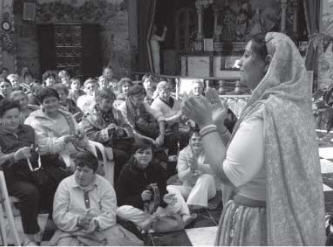
We sincerely hope that more and more people will understand that irrespective of culture and religion it is in our own interest and a mutual target to accomplish sustainability. Furthermore, we hope that in the following years the circle of interested men and women, cooperative partners will increase and a lot more people will visit Krishna valley, the spiritual eco village community.
For further information visit: www.ecovalley.hu
Andras Kun is Scientific Director of Eco valley is MSc, Ecologist, and Scientific counselor at the Botanical and Ecological Institute of the Hungarian Academy of Sciences from 1996. He manages the scientific aspect of projects.
Szilvia Riv is Scientific Advisor, Head of Eco Valley’s EcoLogic workshops and trainings at various universities. She is MSc, Biologist ecologist, floristic and vegetation researcher, public relations coordinator, and communication manager in nature conservation projects.
Radha Krishna Dasa is Head of EVF SSRI and a member of the Board of Directors of Krishna valley.
